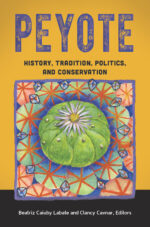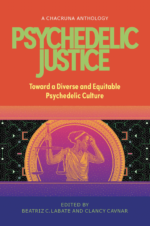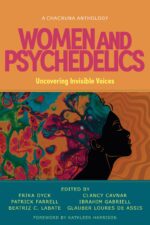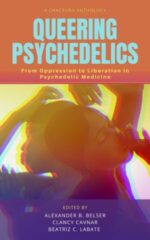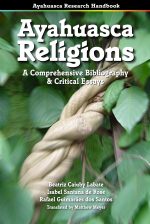- After 2024, the Scenario for Psychedelic Therapies Can Only Improve - January 16, 2025
- Symposium in Brazil Debates Psychedelics at a Political Crossroads - December 13, 2024
- Conference in Rio Defends Psychedelics in Public Health - December 11, 2024
Part 2 – DMT from A to Z, with a stop in Quixadá, Ceará
The scene is unusual: A neuroscientist and an ex-senator go into Brazil’s northeastern hinterland to uproot trees. In 45 minutes, with the help of a tractor, rope, hoe, and chainsaw, three specimens of jurema-preta [black jurema] (Mimosa tenuiflora) tree are extracted, roots and all, as planned. The highest concentration of N,N-dimethyltryptamine (DMT) is found in the roots, which is the reason for the expedition. The consciousness-altering substance is one of the promised new drugs to help patients that psychiatry cannot treat.
The owner of the Logradouro farm near Quixadá, in the Brazilian state of Ceará, is Flávio Torres de Araújo, 77 years-old, physicist and founder of the Ceará Democratic Workers’ Party (PDT). As a substitute for Senator Patricia Saboya, he took over her seat for four months in 2009. He also owns a BMW 1200 motorcycle, on which he would leave in a few days for a trip to Peru.
Dráulio Barros de Araújo, 50, a physicist like his father, has been researching psychoactive substances such as DMT in ayahuasca for 15 years. Studies by his team on the antidepressant effect of the tea helped establish Brazil in third place in a ranking of articles with the greatest impact on the renaissance of psychedelic science.
It had rained all night that May 21st. The waterlogged soil offered no resistance to the extraction of the roots of the populous tree in the semi-arid caatinga region. Father and son work with manager José Edson Pereira da Silva, 49 years-old, who was at the steering wheel of the Massey Ferguson tractor.
The reddish pivot root, sections of the blackened trunk, leaves composed of a number of leaflets, and a few flowers are separated for transport to Natal, 496 km away on the coast. There, they will be processed at the Federal University of Rio Grande do Norte (UFRN), the state in the northeastern corner of Brazil.
Lower parts of the trunks of each tree, still with secondary roots, are returned into the soil, hopefully to sprout and give rise to new plants (which they did, informed Araújo, a few weeks later) and restart the life cycle in the caatinga.
Once the collection is finished, the next stop is at the ranch next to the dam at the farm’s headquarters, at the foot of the huge Pedra da Pendência rock. The block of porphyritic granite is one of the imposing regional set of monoliths of Quixadá, inselbergs (mountain-islands) that dot the landscape.
On the waterside aperitif menu, curimatã roe seasoned with tomato, pepper, and parsley. To drink, cachaça rum from the French oak barrel and beer. The neuroscientist comes out of the water, and, as he passes his father, gives him a kiss on the forehead. He asks him to tell another story, such as the trip on which he took the 11-year-old boy to fish in the Araguaia River in Central Brazil.

Higher up, the 1932 farm house is rustic, with no ceiling under the roof tiles. Flávio Torres, as the former senator is better known, bought the property in 1983. The family traveled there frequently from Fortaleza, capital of the Ceará state. “Much of my personality was formed here on this farm,” says the neuroscientist. Heir to his father’s adventurous spirit, he has been deep-sea diving and skydiving; nowadays, he dedicates himself to surfing.
Araújo the son makes the 1000-kilometer round trip every month, always around the 20th. He wants to analyze the plant at each period of year; in particular, the DMT content in its various parts. He looks for clues about the role of the psychedelic molecule in the plant’s physiology.
Jurema-preta is an abundant and cheap source of the psychedelic, whose extraction takes place in the researcher’s laboratory at the Instituto do Cérebro (Institute of the Brain) (ICe) at the Federal University of Rio Grande do Norte UFRN. Its roots have been used for centuries in indigenous and Afro-Brazilian rituals.
The molecule has become the subject of experiments at the university, which began in June 2022, to verify and quantify the antidepressant effect when administered by inhalation and intramuscular injection. The first healthy volunteers have already received their doses, and the results will later be compared with those of patients with depression recruited at the Onofre Lopes University Hospital (HUOL), at UFRN.
Jurema-preta is an abundant and cheap source of the psychedelic, whose extraction takes place in the researcher’s laboratory at the Instituto do Cérebro (Institute of the Brain) (ICe) at the Federal University of Rio Grande do Norte UFRN. Its roots have been used for centuries in indigenous and Afro-Brazilian rituals.
Jurema-preta is an abundant and cheap source of the psychedelic, whose extraction takes place in the researcher’s laboratory at the Instituto do Cérebro (Institute of the Brain) (ICe) at the Federal University of Rio Grande do Norte UFRN. Its roots have been used for centuries in indigenous and Afro-Brazilian rituals.
Chemist Sérgio Ruschi Bergamachi Silva, 31 years old, has never even put alcohol in his mouth, let alone DMT or any other consciousness-altering substance. He received a strict upbringing from his military father in Monte Alegre, 40 km from Natal, who was surprised when his son told him that he was going to analyze the jurema-preta, which, in his opinion, was only used to make stakes and charcoal.
Ruschi graduated from UFRN in three-and-a-half instead of the usual 4 years. In 2013, at the age of 22, he was approved in a competition for a teaching post in the Federal Rural University of the Semi-Arid Region (UFERSA) in Mossoró, 280 km from Natal. He commuted to Natal by bus, four hours on each leg on the same day, to take MA classes at UFRN. His dissertation dealt with computer simulation of proteins and their molecular interaction with drugs; much theory and programming but little practice on a laboratory bench.
Tired of so much traveling, he managed to move to UFRN in 2017, with a vacancy at the Institute of the Brain, to operate a chromatograph, a piece of equipment used to identify the chemical composition of controlled substances. He liked to talk to patients and this changed his view on drugs: “Psychoactive molecules are not what people describe, nor what I learned all my life,” he says today. “DMT is a molecule like any other.”
The work plan with Araújo, in partnership with the company Biomind, includes developing an optimized method to synthesize N,N-dimethyltryptamine, following the concept of green chemistry, which produces less polluting waste. At the moment, Ruschi is working on a project with the undergraduate student, Érica Pantrigo, to improve the extraction and purification of DMT from jurema. The first batches supply the initial experiments for the clinical trial on depression, in which the psychedelic is inhaled, and also for animal trials.
The material, brought frozen from the Logradouro farm, is dried in an oven for 24 to 48 hours. Crushed, the husks of a root become 150 to 250 g of fine powder with the color of ground cinnamon, and are then subjected to the solvent hexane. Separated from the aqueous phase in a separatory funnel, the hexane undergoes vacuum evaporation and is recovered for further use. From 200 ml of solution, 5 ml remain, frozen for 5 to 8 hours, when DMT precipitates as a crystal. With an average yield of 0.3%, 750 mg of DMT can be obtained from 250 g of root powder. It is enough for 7 to 12 of the variable doses used in the experiment.
Ruschi says he was amazed at the simplicity of the procedure. The real challenge will be the synthesis from scratch, which would result in larger volumes. In order to develop the process, he is working with his former professor of organic chemistry at UFRN, Fabrício Gava Menezes, who moved to Natal from the southern state of Santa Catarina. They will soon start with small amounts, 0.5 to 5 g. Once the process is mastered, which, according to Menezes, should take about five months, they will increase the amount to 20 g, almost 30 times more than that obtained with the extraction from a jurema root.
Menezes and Ruschi also intend to innovate, making modifications to the DMT molecule to enhance its effectiveness. They will use computer models to discover ways of improving the biological and therapeutic effect. “With the modifications, it could then be patented,” explains the specialist from Santa Catarina.
“Psychoactive molecules are not what people describe, nor what I learned all my life,” he says today. “DMT is a molecule like any other.”
Brazilian science, primarily that of the Northeast, has a long history with the DMT molecule. The natural alkaloid was isolated and described by a chemist from the state of Pernambuco, Oswaldo Gonçalves de Lima (1908–1989), who, in the 1940s, extracted it from jurema-preta. And he named it nigerine because of the black color of the tree.
Gonçalves de Lima, initially director of the College of Chemistry, the Escola Superior de Química, later incorporated into the Federal University of Pernambuco (UFPE), founded the Institute of Antibiotics at the University of Recife in 1952, which was also absorbed into UFPE. He published 228 scientific articles, 29 in journals outside Brazil.
One of these articles established his reputation in the psychedelic scientific literature: “Observations on ‘Jurema Wine’ Used by the Pancarú Indians of Tacaratú (Pernambuco),” which was published in 1946 in the Arquivos do Instituto de Pesquisas Agronómicas (Archives of the Institute of Agronomic Research).
Gonçalves de Lima had many interests, from politics—he was imprisoned for two months in 1935, after an attempted Communist Putsch—to German literature, as attested by the 1965 master lecture, entitled “Goethe and Chemistry.” He was also a supporter of the Indigenous peoples of the Americas and an admirer of the defender of Brazilian Indigenous peoples, Marechal Rondon (1885–1958), of the Brazilian army, and anthropologist Darcy Ribeiro (1922–1997).
In October 1942, Gonçalves de Lima visited Jatobá, in the Pernambuco State hinterland, a village of the ethnic group today called the Pankararu. He was accompanied by students and technicians of geological studies in the São Francisco River Valley.
Gonçalves de Lima narrates in the article his frustration at not having been able to witness the ceremony of the ajucá, the “wine” that was made there with the jurema-preta. He was only able to observe its preparation by the Indian, Serafim Joaquim dos Santos. Macerated root zest is squeezed in cold water, which turns red and foamy. After removing the foam, the clay pot receives pipe smoke blown over it in the form of a cross.
Not having observed the wine-induced trance during ceremonies, Gonçalves de Lima quotes the ethnographer Carlos Estevão de Oliveira: “at that moment they gave the impression that the lead sheet of the pseudo-civilization that we had spread over them, although four centuries thick, is not enough to suffocate their beliefs.”
The chemist talks about the Indigenous influence on the Catimbó cults in Pernambuco, who, with African, European, and Indigenous influences, worship the jurema tree, and Caboclo Candomblé in Bahia, a practice that mixes African and Indigenous spirits and deities. The great contribution was the jurema tree, the epicenter of the “not very extensive phytolatry of the Northeastern Indians,” which “only became a sacred tree when it was identified as a delightful means of mental transport.”
With the samples obtained, Gonçalves de Lima applied several chemical methods to extract the alkaloid he called nigerine. It was the first record of DMT in natural organisms, but it later became clear that the same substance had been synthesized in 1931 by Canadian chemist Richard Manske.
The proof that N,N-dimethyltryptamine was the producer of the psychedelic effect came only in 1956, when the Hungarian chemist and psychiatrist Stephen Szara injected an extract of Mimosa tenuiflora into his own muscle, and, well, was transported. Gonçalves de Lima narrates that a member of his team ingested 40 mg of nigerine and only experienced pulse acceleration, auditory exacerbation, and respiratory symptoms (mild dyspnea). “All these phenomena disappeared in 45 minutes,” he recorded.
Gonçalves de Lima applied several chemical methods to extract the alkaloid he called nigerine. It was the first record of DMT in natural organisms
Thirty years after nigerine was isolated, an article in The Alabama Journal of Medical Sciences reported a surprising fact: DMT is present in the healthy human brain, without the ingestion of psychoactive substances. Dimethyltryptamine is produced in the organ on which it exerts a psychedelic effect. Such a discovery would be an excellent argument in favor of the idea that DMT, being endogenous to humans, has everything to be a safe drug if its therapeutic use can be proven. There would, of course, be testing for the range of doses that could be safely used.
With the popularity acquired by ayahuasca among hippies, with works such as The Yagé Letters (1966) (another name for the drink), by William Burroughs (1914–1997) and Allen Ginsberg (1926–1997), only three years after this book was published, there appeared the first restrictions for its use in research.
DMT does not only occur in jurema-preta, in the ayahuasca ingredient chacruna, and in the human brain, but also in other animals, plants and even fungi. A comprehensive overview of its widespread presence can be found in the book Tihkal by Ann Shulgin (1931–2022) and Alexander “Sasha” Shulgin (1925–2014). The couple spent several years synthesizing psychedelics in their home laboratory in California, which they tested in self-experiments with friends. “DMT is, most simply, almost everywhere you choose to look. It’s in this flower here, in that tree over there, and in yonder animal.”
The long passage on DMT in the book begins by pointing to a close relative, 5,6-dibromo-DMT, in the marine sponge Smenospongia ehina and the tunicate Eudistoma fragum. And N,N-dimethyltryptamine itself appears in a type of coral in the Bay of Naples, Paramuricea chamaeleon. The list continues with several fungal species in seven families containing another cousin of DMT, 4-hydroxy-DMT. 5-hydroxy-DMT (bufotenine) and 5-MeO-DMT are also found in toads. Moving on to the plant kingdom, Shulgin begins by relating grasses of the Phalaris genus, such as Phalaris tuberosa, which contain DMT, bufotenine, and 5-MeO-DMT. The plant leaves sheep fed on it reeling. Another genus of intoxicating grass for animals is Lolium, as well as several species of bamboo and reeds.
Among legumes, there are many species of the genera Acacia, Anadenanthera and Mimosa. From the angico Anadenanthera peregrina and its cousin Anadenanthera colubrina, for example, psychoactive snuffs are extracted, which receive names such as paricá, yopo, vilca, huilca and cébil. Another nine legumes also contain DMT. There are also trees of the genus Virola, from whose resin snuff is also produced. Finally, and most importantly, in the large psychoactive family of coffee relatives, the ayahuasca chacruna, Psychotria viridis, is the only one to have DMT.
“DMT is, most simply, almost everywhere you choose to look. It’s in this flower here, in that tree over there, and in yonder animal.”
“Why does DMT occur so widely in living things?” asks Dráulio de Araújo, sitting in the long veranda of the Logradouro farm. His hypothesis, for animals, is that dimethyltryptamine is the engine of the images that appear in dreams, seeing with the eyes shut, or mirations that ayahuasqueros speak of.
The expression became the title of one of his pioneering scientific articles on the psychedelic (“Seeing with the Eyes Shut,” 2012). Functional magnetic resonance imaging revealed that the visions triggered by ayahuasca come from the activation of an extensive neural network involved in vision, memory, and intention. “Several of the effects are very similar to what happens when a person is dreaming. We see our own thoughts, we gain access to our own emotions,” says the neuroscientist, who has had (not always peaceful) experiences with ayahuasca.
More mysterious is the general occurrence of DMT in plants. Araújo speculates that the substance may have a more fundamental biological function, such as preparing organisms for environmental stresses; for example, the long dry period in the caatinga. His practice of taking samples of the Mimosa tenuiflora every month in Quixadá is linked to this idea. He wants to establish how the content of dimethyltryptamine varies in each part of the jurema-preta in the northeastern summer (dry season) and winter (rainy season), in search of clues to the function of DMT.
A more general feature that is envisaged is the anti-inflammatory effect that DMT shares with other psychedelics. As increased levels of inflammation occur in depressed patients, an antidepressant benefit may also be associated with this, in addition to accessing psychic content.
Another factor stimulating Araújo’s scientific imagination comes from studies showing the ability of psychedelics, DMT among them, to activate metabolic pathways associated with the formation of new brain connections. This is what is called neuroplasticity. By opening new paths for the exchange of impulses between neurons, DMT would favor the emergence of thoughts capable of breaking vicious cycles of negative ideas, the rumination that torments severely depressed people. Neuroplasticity would be another process contributing to the antidepressant effect.
A fan of science fiction in films like Dune, and following the suggestion of psychiatrist Marcelo Falchi, Araújo named his lab’s investigation “Projeto Dunas” [Dune Project], also a reference to the typical formations of beaches in the Rio Grande do Norte State. But Araújo likes to refer to it also as “DMT from A to Z.”
The project conceived during Araújo’s stay in California gained momentum with the entry of the company Biomind Labs, directed by the Uruguayan Alejandro Antalich, which, a few months ago, opened its headquarters in Cambridge, England. The aim of the partnership is to test and develop drug formulations and administration protocols more conducive to clinical uses against depression.
Several of the effects are very similar to what happens when a person is dreaming. We see our own thoughts, we gain access to our own emotions
In this preliminary phase with healthy volunteers, Araújo’s group uses jurema-preta DMT for inhalation. When patients with depression enter the scene, a synthetic variant supplied by Biomind and manufactured with the best practices required for medicines will be used. The extraction at UFRN will continue, however, to supply the A-to-Z program.
One of the enigmas that the systematic study of Mimosa tenuiflora may unravel is the effect of jurema wine: in addition to DMT, would the plant itself supply beta-carbolines that inhibit the MAO enzyme that degrades the psychedelic in the digestive tract? So far, it has been speculated that such blockers are present in other vegetables that go into the ceremonial drink, such as wild varieties of cashew and passion fruit. However, they are not used everywhere where wine is made. It may be that the mystery has no biochemical solution. It is also possible that access to the enchanted realms opens with the rituals themselves, without direct psychedelic influence.
Jurema preta is just one of the 38 species of the Mimosa genus existing in the caatinga (out of the 350 found in Brazil, among the 540 in the world). Some also contain DMT, but Mimosa tenuiflora has become a favorite for rituals. The reason may lie in the high content of DMT, or even in its widespread presence in the northeastern hinterland.
The rusticity of the jurema leaves an echo even in the name of the tree that, in the indigenous language Tupi, means “many thorns.” Even in a semi-arid environment, it reaches up to 5.5 m in height and 30 cm in diameter at the trunk. Its dominance of the caatinga landscape comes from its unusual tolerance to different soil conditions and water deficits. In the dry season, it loses all its leaves, which return green with the first rains. White flowers also appear, usually in November and December. The high content of tannins, origin of the bitterness of the drink prepared with jurema, does not prevent cattle and goats from feeding on the shoots in winter and on the leaves and pods in the dry season.
Its resistant wood is denser than eucalyptus. Hence the preference of the sertanejos, the traditional dwellers of the hinterlands, as indicated above by the father of the chemist Sérgio Ruschi, to obtain fence posts and charcoal. As a legume, it contains in its roots, in symbiosis, bacteria that fix nitrogen from the atmosphere in the soil, enriching the poor lands of the caatinga with this important nutrient. It is a suitable tree for reforestation, as it grows fast, 4.5 meters in five years, and 75% of the seedlings survive this period.
All this resilience, however, may not be enough to face the growing human presence in the dry sertão hinterland. More than half of the caatinga biome has already been deforested, and 13% is in the process of desertification. The amount of surface water, such as that in rivers and reservoirs, shrank 8% from 1985 to 2020, according to the MapBiomas network. The presence of the jurema-preta, despite its abundance, has not been left unscathed by this devastation. According to a genetic study by Seni Reis Arruda, from the State University of Southwest Bahia (UESB) in Vitória da Conquista, the fragmentation of the caatinga is already reducing the gene flow between separate populations of Mimosa tenuiflora.
Without sufficient pollen and seed dispersal, trees reproduce only with cousins confined to the same area. This shrinks the variety of genes available to make the tree robust in the face of varying environmental conditions. Over time, this reduction of diversity could pose a risk to the survival of the species.
Anyone who sees Dráulio Araújo and Flávio Torres pulling out just three trees of jurema-preta from the extensive jurema population in the bushes of the Logradouro farm can conclude that it will make no difference to the number of trees. After all, at the rate of three specimens a month to obtain a few hundred milligrams of DMT, no more than a mere 36 trees a year will be used.
Father and son, however, take care to return the stumps of the cut trees to the earth with their secondary roots so that they sprout and continue to restore the vigor of the caatinga. At the same time, working side by side, they renew their mutual affection and the possibility that the study with DMT will help to alleviate the suffering of millions of depressed people.
The third part of this series will appear here on Friday Aug. 26
This is the second part in a series originally published in Portuguese by the Brazilian daily newspaper Folha de S.Paulo https://www1.folha.uol.com.br/ilustrissima/2022/07/da-caatinga-ao-laboratorio-cientistas-investigam-efeito-antidepressivo-de-psicodelico.shtml
Take a minute to browse our stock:
Did you enjoy reading this article?
Please support Chacruna's work by donating to us. We are an independent organization and we offer free education and advocacy for psychedelic plant medicines. We are a team of dedicated volunteers!
Can you help Chacruna advance cultural understanding around these substances?



